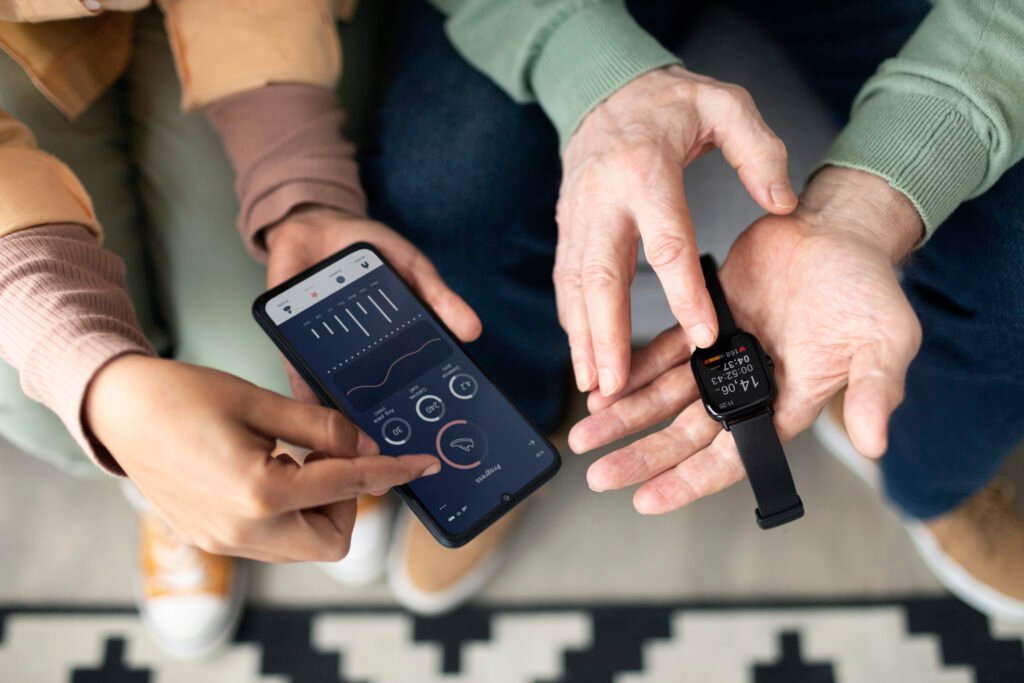Introduction
Wearable technology is evolving faster than ever. What started with simple fitness bands and smartwatches has now expanded into smart clothing, rings, glasses, and even implants that track our health in real time. As innovation accelerates, wearable technology trends in 2025–2026 are pushing the boundaries of convenience, connectivity, and personal wellness.
From healthcare to entertainment, wearable tech is becoming an essential part of daily life. At SMA Techs, we explore seven major wearable technology trends shaping the future of how we live, work, and interact with technology.

1. Smart Rings: The Next Big Thing in Wearable Tech
Move over, smartwatches — smart rings are quickly emerging as a discreet and stylish alternative. These tiny devices can monitor your heart rate, track sleep quality, measure stress levels, and even make payments with a simple tap.
Brands like Oura, Ultrahuman Ring Air, and Circular are leading the charge, offering minimalist designs packed with advanced sensors. As AI integration improves, smart rings will soon become capable of detecting early health warnings or syncing seamlessly with other devices in your smart ecosystem.
Why it matters: Smart rings represent the perfect blend of convenience, fashion, and health tracking — ideal for users who prefer lightweight, always-on tech.
2. Smartwatches Are Getting Smarter
Smartwatches remain the cornerstone of wearable technology trends, but 2026 models are taking things to the next level. Devices like the Apple Watch Ultra, Samsung Galaxy Watch 7, and Fitbit Sense 3 are now integrating advanced AI for predictive analytics and personalized health insights.
Beyond step counting, smartwatches now analyze sleep stages, detect irregular heart rhythms, measure skin temperature, and even monitor blood oxygen levels. They’re becoming essential for preventive healthcare and fitness optimization.
Trend insight: Expect future watches to feature non-invasive glucose monitoring and AI-powered stress management, making them indispensable health companions.
3. AI-Powered Wearables for Personalized Insights
Artificial Intelligence (AI) is redefining what wearables can do. Modern devices don’t just collect data — they interpret it. AI algorithms analyze your activity, sleep, and mood to provide personalized recommendations for better well-being and productivity.
For example, AI-powered wearables can:
- Suggest ideal workout times based on energy levels.
- Detect early signs of fatigue or dehydration.
- Integrate with smart home installation systems to adjust lighting or temperature based on your physical state.
Future outlook: Expect wearable AI assistants that anticipate your needs — not just respond to them.
4. Smart Clothing: Fashion Meets Function
The next wave of wearable technology trends is entering our wardrobes. Smart clothing — equipped with embedded sensors — can monitor posture, muscle activity, and body temperature.
Brands like Lumo, Hexoskin, and Levi’s Jacquard are developing connected apparel for athletes, healthcare professionals, and everyday users. Imagine yoga pants that correct your posture or shirts that track respiratory patterns during workouts.
Why it’s trending: The fusion of fashion and function makes smart clothing one of the most promising wearable tech innovations.
5. AR Glasses and Mixed Reality Experiences
Augmented Reality (AR) and Mixed Reality (MR) wearables are finally going mainstream. Tech giants like Apple, Meta, and Snap are leading with lightweight, stylish AR glasses that overlay digital information on the real world.
By 2026, AR glasses will allow users to:
- Navigate hands-free using 3D directions.
- Translate languages in real time.
- Access health data or notifications without checking their phone.
This trend is not just about gaming or entertainment — it’s about enhancing everyday productivity with real-time, context-aware information.
6. Health-Focused Wearables and Medical Integration
One of the most transformative wearable technology trends is the integration of wearables into healthcare. Devices are evolving from fitness trackers into medical-grade monitors that help doctors diagnose and track conditions remotely.
For instance:
- Continuous glucose monitors (CGMs) are helping diabetic patients manage blood sugar.
- ECG-enabled devices can detect heart abnormalities early.
- Smart patches are emerging to deliver medication transdermally.
Healthcare providers are embracing wearables for preventive care, remote monitoring, and telemedicine — bringing medicine closer to the patient than ever before.
7. Sustainable and Energy-Efficient Wearables
Sustainability is no longer optional — it’s a necessity. As consumers become more eco-conscious, the next generation of wearables will prioritize energy efficiency and recyclable materials.
Emerging innovations include:
- Solar-powered fitness trackers.
- Biodegradable smart fabrics.
- Energy-harvesting wearables that generate power from body movement.
Tech companies are focusing on reducing e-waste and improving battery longevity, ensuring the future of wearables is both smart and sustainable.
Bonus Trend: Integration with Smart Homes and IoT
Wearable devices are becoming central to the Internet of Things (IoT) ecosystem. From adjusting your thermostat via smartwatch to unlocking your car with a smart ring, wearables will seamlessly connect to your surroundings.
As brands like Amcrest Smart Home and Wavetechglobal.com Smart Home Gurus continue to innovate in AI-powered ecosystems, wearables will play a key role in building smarter, more responsive environments
Conclusion
From smartwatches to smart rings, the future of wearable technology is all about connection, personalization, and intelligent living. These wearable technology trends highlight how innovation continues to blur the line between the digital and physical worlds.
As devices become smaller, smarter, and more sustainable, wearables will empower people to take control of their health, productivity, and environment — making 2026 the most exciting year yet for tech enthusiasts and everyday users alike.
